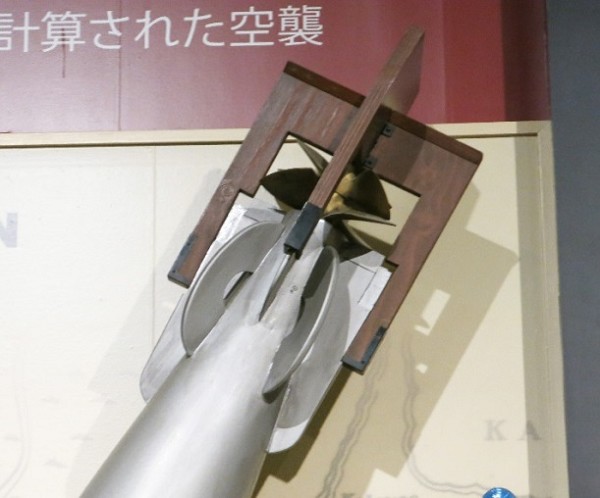U-M LAB WINS FAME: Marine Hydrodynamics Stars in Pearl Harbor Documentary
December 8, 2016
Leave a Comment
|
||||||||||
| Printer Friendly Story View |

Japanese torpedoes used at Pearl Harbor had wooden fins to stabilize their path toward U.S. ships. (Pacific Aviation Museum photo)
The University of Michigan's Marine Hydrodynamics Laboratory in Ann Arbor has figured in the making of a documentary analyzing the Japanese attack on Pearl Harbor on Dec. 7, 1941.
The documentary, that aired recently on the American Heroes Channel, makes the case that Japanese technology allowing aerial dropped torpedoes to work successfully was key to the devastation the American fleet experienced in the surprise attack.
The Japanese were informed by a British aerial torpedo attack on Italian ships at Taranto on Nov. 11-12, 1940. The British compensated for the proclivity of aerial-dropped torpedoes to plunge at least 75 feet into the water before leveling out, a characteristic that would have led to failure at Taranto, the harbor of which was only about 60 feet in depth.
Pearl Harbor was only about 40 feet deep, so Japan needed to modify its tactics and torpedoes to attack successfully.
The Royal Navy had developed a new method of preventing torpedoes from diving too deep and exploding uselessly on the ocean floor or sticking in the mud. A drum was attached beneath the nose of the aircraft, from which a roll of wire led to the nose of the torpedo. As it dropped, the tension from the wire pulled up the nose of the torpedo, producing a belly-flop rather than a nose dive.
The Japanese studied what had happened at Taranto, including visiting the harbor and interviewing Italian naval personnel. The decided to use wooden fins that would break off upon impact with the water and keep the torpedo level and on course to strike the U.S. ships. The AHC television documentary explained this technology through a demonstration at the U-M hydrology lab; a 1/5 scale model of a Type 91 Kai 2 torpedo with mock wooden roll control fins was dropped at scale speed into a long water tank. This was done five times.
High-speed cameras captured each water entry and subsequent motion of the torpedo model. In this demonstration, the wooden tail frames caught briefly when they hit the water, then broke off. The model quickly returned to the surface.
This demonstration was led by Dr. Guy Meadows, director of the Marine Hydrodynamics Lab at the University of Michigan.
The documentary showed the devastating effects of the Japanese attack using aerial-dropped torpedoes.
The production of torpedoes and their last minute delivery to Japanese carriers headed toward Pearl Harbor seems to have been an unexplained, but vital, part of the solution not addressed in the documentary.
"Now the problem was producing enough of the modified Kai 2 torpedoes for the attack, states "Pearl Harbor: Thunderfish in the Sky," a production of the Pacific Aviation Museum at Ford Island, Honolulu, Hawaii.
http://www.pacificaviationmuseum.org/pearl-harbor-blog/pearl-harbor-thunderfish-in-the-sky#_ftn80
"Japan produced Type 91 torpedoes in the Nagasaki Weapons Factory operated by Mitsubishi Heavy Industries. Its production schedule would not make enough torpedoes available until the end of November. That would be too late. Mitsubishi would not permit overtime work, and the factory's manager, Yukio Fukuda, could not be told about the dire time need for the final torpedoes.
"However, Fukuda was able to read between the lines. He authorized the overtime. Even so, only 50 of the torpedoes were available when the fleet sailed for Hitokappu Bay, where they would sortie against Pearl Harbor. One ship, Akagi, remained behind to receive the final batch. Akagi reached the fleet on November 24, only two days before the fleet steamed out of the bay."
The museum analysis concluded: "On Dec. 7, 1941, Japan proved that it had mastered shallow-water torpedo strikes. After the attack, a shocked U.S. Navy examined the remnants of Japanese torpedoes. They saw that the dropped torpedoes had big wooden fins at the back of their tail cones. These big wooden fins, which were fitted over smaller metal fins, broke off when the torpedo hit the water. The Navy also saw that there were two smaller fins near the front of the tail cones. These were again made of metal covered with wooden gloves that snapped off at water entry."
###
| Printer Friendly Story View |
|
|

Dave Rogers |
|
|
|
Printer-Friendly Story View
0200 Nd: 04-15-2024 d 4 cpr 0
12/31/2020 P3v3-0200-Ad.cfm
SPONSORED LINKS
12/31/2020 drop ads P3v3-0200-Ad.cfm


